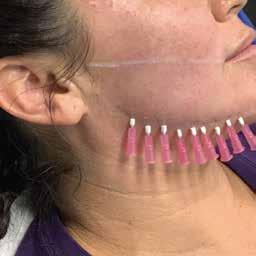THREADS
COG THREADS

Cog threads, also known as PDO (polydioxanone) threads or thread lifts, are a minimally invasive cosmetic procedure used to lift and tighten sagging skin on the face and body. They consist of dissolvable threads made of a biocompatible material called polydioxanone, which is commonly used in surgical sutures
Cog thread lifts are typically used to address sagging skin and tissue laxity in areas such as the cheeks, jowls, jawline, neck, and brows. They are often preferred by individuals seeking a less invasive alternative to traditional surgical facelifts, as they involve minimal downtime and carry fewer risks and side effects.
Here’s how cog threads work:
Insertion
During a thread lift procedure, a healthcare provider inserts the cog threads into the skin using a thin needle or cannula. The threads are strategically placed in the deeper layers of the skin to provide support and lift to areas of sagging or laxity.
Collagen Stimulation
In addition to providing an immediate mechanical lift, cog threads stimulate the body’s natural healing response. As the threads dissolve over time, they trigger the production of new collagen and elastin fibers in the skin. This leads to gradual improvements in skin texture, firmness, and elasticity, resulting in longer-lasting rejuvenation effects.
Mechanical Lift
Cog threads have a unique design with tiny barbs or cogs along their length. These barbs anchor the threads to the surrounding tissues, allowing them to pull and lift the skin when tension is applied. This creates an immediate lifting effect, similar to the results achieved with traditional surgical facelifts.
Biodegradation
Similar to cog threads, polydioxanone threads are gradually broken down and absorbed by the body over several months. As the threads dissolve, the newly formed collagen fibers provide ongoing support and structure to the treated areas, prolonging the rejuvenation effects.
Results
The results of a mono thread treatment are visible gradually over the course of several weeks to months as collagen production increases. While the initial lifting effect may be subtle, the overall improvement in skin quality and firmness can be long-lasting, lasting for up to a year or more.
MONO THREADS
Mono threads, also known as monofilament threads, are another type of absorbable thread used in cosmeticprocedures for skin rejuvenation and lifting. Like cog threads, mono threads are made of polydioxanone (PDO), a biocompatible material commonly used in surgical sutures. However, unlike cog threads, mono threads do not have barbs or cogs along their length.
Mono threads are commonly used to address skin laxity, fine lines, and wrinkles in areas such as the cheeks, jawline, neck, and décolletage. They are often preferred by individuals seeking a minimally invasive alternative to surgical facelifts or as a complement to other cosmetic procedures.

Here’s how mono threads work:
Insertion
Mono threads are inserted into the skin using a thin needle or cannula. They are placed in a mesh-like pattern beneath the skin’s surface to provide support and stimulate collagen production.
Collagen Stimulation
Once inserted, mono threads stimulate the body’s natural healing response. As the threads dissolve over time, they trigger the production of new collagen and elastin fibers in the skin. This leads to gradual improvements in skin texture, firmness, and elasticity, resulting in a more youthful and rejuvenated appearance.
Tissue Tightening
While mono threads do not have barbs like cog threads, they still provide a subtle lifting and tightening effect by gently compressing the surrounding tissues. This helps to improve skin laxity and reduce the appearance of fine lines and wrinkles.
Biodegradation
Polydioxanone, the material used to make cog threads, is gradually broken down and absorbed by the body over several months. As the threads dissolve, the newly formed collagen fibers provide ongoing support and structure to the treated areas, prolonging the lifting and tightening effects.
Results
The results of a cog thread lift are visible immediately after the procedure and continue to improve over the following weeks as collagen production increases. While the initial lifting effect may last for several months, the overall rejuvenation effects can persist for up to a year or more, depending on individual factors such as skin quality, lifestyle, and aging process.
